 |
 |
|
 |
A message from Lt. Gov./Commissioner Molnau |
 |
 |
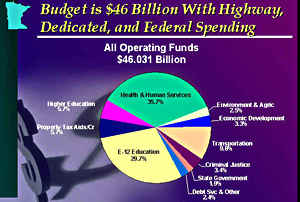 |
Gov. Tim Pawlenty on Feb. 18 presented his state budget proposal for
the next two years. Under the governor's proposal, Mn/DOT will need
to realign its spending priorities—with a focus on decreasing administrative
and overhead costs—to achieve a budget reduction goal of $42 million
per year. Graphic courtesy of Gov. Pawlenty's Web site
|
Note: The following is a message from Lt. Gov./Commissioner Carol Molnau
to Mn/DOT employees about the governor’s budget proposals announced on Feb.
18.
Yesterday, Gov. Tim Pawlenty announced his proposed state budget for FY 2004-05.
The governor’s plan asks state agencies to make improvements
and changes to increase efficiency. As you know, we continue
to focus on streamlining Mn/DOT, such as the organizational
restructuring announced last week. But there is more work
we must do to address the budget reductions outlined in the
governor’s plan.
The governor asked Mn/DOT to realign its spending priorities—with a significant
focus on decreasing administrative and overhead costs—to achieve a budget reduction
goal of $42 million per year. There are no proposed cuts to the construction
program.
Our first step is to determine how we’re going to meet this reduction without
sacrificing safety and while staying on task to deliver our construction program.
The division directors will begin looking at how to meet the governor’s recommendations,
and then will meet with the office directors and district engineers for their
input.
Mn/DOT will definitely be a part of the state’s budgetary solution. In a few
weeks, we will announce a transportation investment package for Minnesota that
will outline funding priorities. At that time, we will be able to release our
plan to meet Mn/DOT’s budget reduction goals. Although we can only contribute
minimally with general fund dollars, we will be taking a critical look at how
trunk highway funds are allocated and spent.
We will continue to look at the suggestions submitted by employees and taxpayers
to generate revenue, reduce costs and increase accountability. In fact, we already
are implementing some of them and will continue to look at all ways to reduce
spending.
Once again I must ask you to be patient during this process. It will be some
time before we have answers to all your questions since the governor’s proposal
is just the beginning of the budget process. During the next few months, the
Legislature will consider both the governor’s proposal as well as budget proposals
coming from both the House and the Senate.
I know these are times of uncertainty, but you can be certain that you are
among the best employees in the state. I thank you for your hard work and dedication
to the taxpayers of Minnesota.
For more information about the budget proposal, check the Governor’s
Web site. And please continue to visit the Commissioner’s
Web site for more information about Mn/DOT’s reorganization, cost-cutting
ideas and other topics.
|
back

|
 |
10-year highway work plan tells whole story of construction
costs |
 |
 |
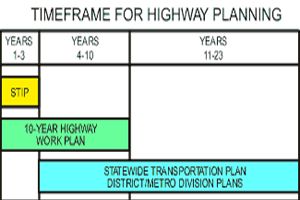 |
This chart shows the timeframes for various elements of Mn/DOT’s highway
investment planning process. The 10-Year Highway Work Plan is one element.
Others are the Statewide Transportation Plan, District/Metro Division
Plans and the State Transportation Improvement Program.
|
Beginning this month, employees who want to know the actual total costs of
a construction project from start to finish can find the answer in Mn/DOT's
10-Year Highway Work Plan for 2003-12.
The new plan should give a clearer, more comprehensive picture of highway construction
costs, including land acquisition, project development and contact with public
and elected officials, according to Al Schenkelberg, director, Office of Investment
Management
"Besides actual construction, Mn/DOT’s new 10-year highway work plan now
includes such cost factors as design, right-of-way and construction engineering,"
Schenkelberg said. "These costs are also adjusted to reflect predicted
inflation."
Schenkelberg said that the new process should help clear up confusion about
actual costs by providing consistent and accurate estimates for the total costs
of projects. Employees can use these figures for all documents and reports until
new estimates come out each fall.
Mn/DOT is launching this new process in order to present a clearer and more
comprehensive description of highway costs.
"Taxpayers, partners and legislators have not understood or appreciated
the true cost of transportation," Schenkelberg said. "The new plan
process should give our customers a better understanding about why projects
take as long as they do, that there is much more to construction than just the
construction phase. All these phases can create delays and increase costs."
Beginning with this year’s work plan, cost estimates will be used consistently
by all Mn/DOT employees and in all documents until new estimates are released
each fall with submission of the State Transportation Improvement Program for
federal approval.
"The districts and Metro Division will now review and update all project
cost estimates each year using the length, width, depth estimation process,"
said Bob Hofstad, OIM. "They are also responsible for documenting the reasons
for changes in project cost estimates and project delivery dates. Documentation
will be done through the Program and Project Management System."
The plan includes all trunk highway projects costing more than $1 million in
the bridge replacement, major construction and reconstruction categories during
fiscal years 2003-12. It includes three years of state highway projects programmed
in the 2003-05 state transportation improvement plan and seven years of projects
proposed by Mn/DOT districts and Metro Division for construction.
All projects in the 10-year work plan are now shown by District/Area Transportation
Partnership, trunk highway, project description, program category, construction
fiscal year, design estimate, right-of-way estimate, year of construction estimate,
construction engineering estimate and total cost of project. The state fiscal
year refers to the year that project construction is expected to begin.
The year of construction costs in the work plan are computed by taking the
current project cost in 2002 and applying an inflation factor. For projects
in state fiscal years 2003 through 2005, right-of-way costs are included for
each project. For projects in fiscal years 2006-12, a description of the anticipated
extent of right-of-way for each project is provided. Design and right-of-way
costs typically occur before a project is constructed. Construction engineering
costs occur as the project moves through construction. Total project costs are
shown for only those projects programmed in the STIP since right-of-way cost
estimates are included in the costs of those projects.
The 10-Year Highway Work Plan for 2003-12 is now posted on iHUB at http://ihub.dot.state.mn.us/tenyearplan.
The site includes tools for communicating the new cost estimating and reporting
process in your office or district. For more information, contact Bob Hofstad
at 651/296-8519.
By Donna Lindberg
|
back

|
 |
Living snow fences corral drifting snow |
 |
 |
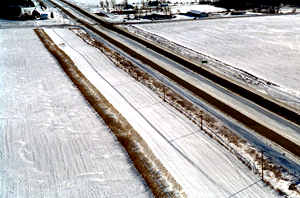 |
This living snow fence uses standing rows of cornstalks to help keep
Hwy 212 drift-free east of Glencoe. Photo by Neil Kveberg
|
It was plant life against the weather last week when wet, heavy snowfall hit
western Minnesota Feb. 11. The plant life helped Mn/DOT score a significant
victory as a 2,500- foot long living snow fence near the highways kept blowing
and drifting snow from advancing past the fog line along Hwy 212 east of Glencoe.
This scenario occurred in dozens of other locations as well, and provided a
demonstration of the value of snow fences. Some snow fences consist of rows
of cornstalks left standing after the harvest. Others are rows of trees, shrubs
and grasses planted along the state’s highways.
And one week later, when fierce winds raked the state again, snow fences diminished
the blowing snow that often reduced visibility to less than a quarter of a mile,
according to maintenance crews around the state. (See the Feb.
5 Mn/DOT Newsline article.) The rows of vegetation disrupted the
wind’s flow, causing air currents to drop the snow before it reached the roadway,
or hampered visibility.
This winter Mn/DOT contracted with 45 landowners to leave cornstalks standing
as living snow fences, said Dan Gullickson, living snow fence coordinator, Environmental
Services. Keeping drifts off the roads, he said, increases safety for motorists
and reduces the time and equipment Mn/DOT maintenance crews need to keep roads
open.
The cost savings can be significant, he said, adding that a benefit cost ratio
of $17 to $1 can reduce crashes as well as the costs for labor, equipment and
materials. Clearer roads also limit travel delays for commercial vehicle operators,
emergency service providers and the driving public.
"Planting snow fences in partnership with farmers provides a low-cost
and very effective method for Mn/DOT to maintain safety and mobility on the
state’s roads," Gullickson said.
By Craig Wilkins
|
back

|
 |
Consultants play key role in project delivery |
 |
 |
With the recent articles in the Star Tribune and the newly formed Mn/DOT
Contract Management Team, consultant contracts have garnered several headlines.
Consultant usage is not new, however; consultants have helped to deliver projects
for a number of years, especially with tight deadlines attached to the Legislature’s
one-time-only funding bill in 2000.
"In order to meet the deadline, we turned to consultants," said Dick Stehr,
division director, Engineering Standards. "We couldn't hire and train the additional
workforce in time."
Stehr said that hiring consultants offered a temporary solution without inflating
Mn/DOT’s workforce. Mn/DOT is staffed to deliver $400 million in transportation
projects, he said, but the additional one-time-only legislative funding—which
came with a June 30, 2003 deadline—meant doubling project delivery capability.
According to Stehr, 90 percent of Mn/DOT consultant agreements contribute directly
to program delivery. Mn/DOT used consultants for approximately 16 percent of
its work prior to the one-time funding, he said, adding that this is less than
many other states. He cited a 1998 survey that shows 45 percent of the other
states use consultants for more than 50 percent of their engineering work.
Minnesota’s usage is on the low end, Stehr said, because Mn/DOT has chosen
to retain technical staff and use their skills.
There are, however, some issues with using consultants, Stehr said. Pressure
to deliver projects faster sometimes conflicts with the methodical process used
to select and hire consultants. The scope of a given project may change, he
said, thanks to discoveries during a project’s development phase. In addition,
Stehr said, amendments might inflate initial contracts, but many amendments
involve extra time with no extra costs.
Mn/DOT recently decentralized the contract function and now other Mn/DOT offices
and districts do more of the contract process, including hiring consultants,
Stehr said. Mn/DOT hires consultants for several reasons, including:
- Aerial photography
- Bridge design
- Bridge steel fabrication
- Contaminated properties
- Preliminary and final design
- Photogrammetric mapping
- Materials drilling and testing
- Noise analysis and appraisals
Mn/DOT uses consultants for all aerial photography and contaminated properties,
Stehr said, adding that percentages vary from five percent to 70 percent in
the other areas. He said Mn/DOT is also improving compliance with contract procedures
through classes taught by consultant services professionals and in the Project
Management Academy.
"Employees need to know that it's a misdemeanor to violate the law, so we want
to make every effort to ensure they know what the process requires," Stehr said.
Lt. Gov./Commissioner Molnau and Commissioner of Administration Brian Lamb
are heading up the new Mn/DOT Contract Management Team. The team’s charge is
to recommend changes by March 31 to improve contract procedures. Stehr, a team
member, said that he believes that the outcome will be a contracting process
that strikes the right balance between accountability and flexibility.
The bottom line, Stehr said, is that Mn/DOT needs to ensure that taxpayers
are receiving good value for their money.
By Sue Stein
|
back

|
 |
Subzero winds complicate critical guardrail repair task in
Metro Division |
 |
 |
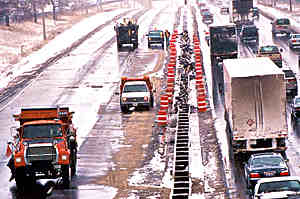 |
High traffic volumes on this stretch of I-494 made it a high priority
for Cedar Truck Station crews to repair this damaged guardrail (despite
equipment breakdowns and subzero temperatures) before the next morning’s
rush hour. Photo by David Gonzalez
|
As strong winds blew snow across the state and sent the windchill to 12-degrees
below zero on Jan. 28, highway maintenance crews went to battle against the
elements. They all returned safely from their labors, but some of the machines
used by Metro Division maintenance crews did not.
Several vehicles and pieces of equipment broke down in the subzero temperatures,
but Metro Division Cedar Ave. Truck Station crews nonetheless managed a critical
repair within less than 24 hours: a damaged guardrail on heavily traveled I-494
on the eastern side of the borders between Richfield and Bloomington south of
Minneapolis.
The saga began, as do so many stories in Mn/DOT, with a traffic crash and a
rapid response by maintenance crews. This one began around 10:30 a.m. when a
semi-trailer jackknifed into the median barrier near Portland Avenue, taking
out 825 feet of guardrail. The Cedar Avenue Truck Station day shift responded
quickly and the night shift reported to work early as well.
Despite cold-related breakdowns by vehicles and equipment, the Cedar Avenue
day and night crews still completed the repair overnight, restoring the guardrail
before the next morning rush hour.
The work wasn’t easy. Two loaders and a skidsteer broke down. Three lifting
cables snapped as well. The crews went through 36 carbide auger bits, 12 chop
saw blades, four hammer handles and 12 pairs of gloves in 12 hours.
The day shift handled the first stage, clearing and cleaning up the freeway,
which normally carries more than 130,000-plus cars a day.
After they finished, the Cedar Avenue shop’s night shift reported for work
two hours early to gather supplies and equipment for repairing the damaged section
of guardrail. Night crew members worked without breaks for the next 12 hours,
removing and replacing 56 guardrail posts originally set in concrete and frozen
clay.
By 6:30 a.m., all lanes reopened to traffic, just in time for the morning’s
heavy commuter traffic. Jim Michael, central region maintenance superintendent,
had high praise for everyone involved.
"Both the day and night crews at the Cedar Avenue shop did a fantastic job
coordinating and completing the guardrail repair in less than 24 hours, under
winter conditions that were obviously less than perfect," he said.
Metro Newsline (editor: Kent Barnard, Metro Division Communications Office)
covered this event in their February 10 edition as well. For more information
about this and other district and Metro activities, visit their online district
newsletters from the links on the blue sidebar. Click on the newsletter links
on the blue sidebar on the main Newsline Web page or follow these links:
|
back

|
 |
Hiawatha LRT-Korean Peace Garden wins award |
 |
 |
 |
Gardening near the downtown Minneapolis skyscrapers doesn’t seem to
disturb this gardener. Many Korean immigrants gardening near Hiawatha
Ave. raise crops to support their families, but their work’s aesthetic
value recently earned an environmental award. Hiawatha Project Office
staff photo
|
During warmer weather, an avid farming and gardening community thrives in an
unusual spot: between heavily traveled I-94 next to downtown Minneapolis and
right of way for the Hiawatha Light Rail Transit project.
That's the spot where members of the Korean community tend to their plots of
vegetables and flowers in the Korean Peace Garden during Minnesota's growing
season.
The gardens serve as an important cultural landmark for the local Korean community,
but they serve an aesthetic function as well. The plots are like an oasis in
the desert amid the downtown skyline, concrete roads, rumbling highway traffic
and tunes from the nearby eateries and bars.
In recognition of the Korean Peace Garden's value, the City of Minneapolis
and the U of M Design Institute honored the LRT Project last month with a coveted
Committee on Urban Environment Award. The CUE Award recognizes significant achievement
in urban design and aesthetic excellence for projects that build community and
bring a high quality of life to Minneapolis.
Mn/DOT and the Metropolitan Council play host to the Peace Garden, which is
wedged between I-94 and Cedar Avenue adjacent to the LRT Maintenance Facility
on land owned by the Metropolitan Council and Mn/DOT. The Hiawatha Project Office
relocated the Korean Gardens from their previous location along Hiawatha Avenue
when ground broke on LRT, thus creating a "win-win" situation for both LRT and
the community.
By Joshua Collins
|
back

|
 |
New bridge awards announced |
 |
 |
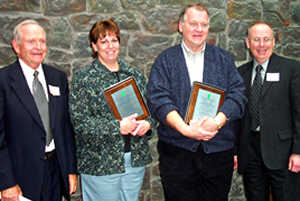 |
Accepting this bridge quality construction award are (from left): Wayne
Murphy AGC; Liz Benjamin, resident engineer, Metro Division; Joe Forpahl,
supervisor, Metro Division; and Dan Dorgan, State Bridge Engineer. The
bridge they constructed is at Hwy 100 and 36th Ave. N. in Crystal just
west of Minneapolis. Photo by Paul Kivisto
|
The high quality of bridge construction around the state in the past two years
has sparked the beginning of a new annual Bridge Construction Awards program
to recognize quality efforts. On Jan. 30 Mn/DOT and the Association of General
Contractors jointly presented awards at the 2002 Bridge Construction Awards.
A ratings panel evaluated nine projects submitted in three categories based
on bridge construction cost. The evaluation criteria included quality of material,
overall workmanship, project complexity, and innovations made during the project.
The winners were:
Bridges costing less than $1.5 million—Hwy 7 bridge off-ramp over a
trolley line in Excelsior west of Minneapolis; Mn/DOT Metro Division staff:
Mark Panek, resident engineer; Steve Barrett, project engineer; Jon Erickson,
chief bridge inspector; Contractor: Edward Kraemer and Sons, Inc.
Bridges costing between $1.5 million and $8 million—The bridge at Hwy
100 and 36th Avenue North in Crystal west of Minneapolis; Mn/DOT Metro Division
staff: Liz Benjamin, resident engineer; Joe Forpahl, project supervisor; Larry
Lehrke, chief bridge inspector; Contractor: Edward Kraemer and Sons, Inc.
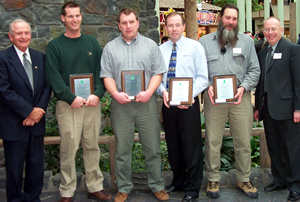 |
Accepting awards are (from left): Wayne Murphy (AGC rep); Mark Panek,
resident engineer; Tom Villar, project supervisor; a representative
from Johnson Bros., Inc., the contractor; Mark Mueske, chief bridge
inspector; and Dan Dorgan (Mn/DOT State Bridge Engineer). Photo by
Paul Kivisto
|
Bridges costing more than $8 million—Penn Avenue Bridge across Hwy 494
between Richfield and Bloomington south of Minneapolis; Mn/DOT Metro Division
staff: Mark Panek, resident engineer; Tom Villar, project supervisor; Mark Mueske,
chief bridge inspector; Contractor: Johnson Bros. Inc.
Mn/DOT’s Office of Bridges and Structures also recognized two other projects
built by non-AGC contractors and will present these awards separately at a later
date. These winning projects are: he list is as follows:
Bridges costing less than $1.5 million—Hwy 87 over the Crow Wing Chain
of Lakes near Park Rapids in northwestern Minnesota; Mn/DOT Bemidji/District
2 staff: Todd Vanasek, resident engineer; Roger Bachmann, project supervisor;
Larry Randall, chief bridge inspector; Contractor: Redstone Construction.
Bridges costing between $1.5 million and $8 million—Hwy 371 under Hwy
371 Business Connection Bridge in Brainerd in eastern Minnesota; Mn/DOT Brainerd/District
3 staff: Kevin Kosobud, resident engineer; Paul Koening, project supervisor;
Tim Nielsen, chief bridge inspector; Contractor: Redstone Construction
|
back

|
 |
|
 |



